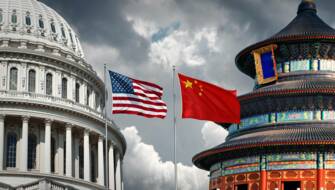#Corporate news
Coface UK & Ireland: Officially a Great Place to Work
We’re proud to announce that Coface UK & Ireland has been officially certified as a Great Place to Work®.

Explore Coface's comprehensive Risk Dashboard, providing in-depth risk assessments for 160 countries and 13 industry sectors to make strategic decisions
#Corporate news
We’re proud to announce that Coface UK & Ireland has been officially certified as a Great Place to Work®.
Headlines UK growth forecast at just 1% in both 2025 and 2026, falling behind the EU and other advanced economies by 2026 Inflation expected to peak at 3.5% in Q3 2025, and remain above the 2% target through 2026 Private sector momentum weakening, with Autumn budget and tariffs adding pressure Corporate insolvencies rising again, now forecast to increase by 3% in 2025 Three sector downgrades: automotive, chemicals, and metals now rated Very High Risk
Trump’s 2024 election victory has reignited global trade tensions, with a new wave of aggressive tariffs triggering widespread disruption and uncertainty. In this article, Andre van Niekerk, Head of Consulting and Insights, and Jonathan Steenberg, Economist at Coface UK, examine the impact of these measures, the risks they pose to international businesses, and how companies can adapt to the evolving trade landscape.
#Economic publications
On 30 October, Presidents Xi Jinping and Donald Trump met for the first time since 2019, on the sidelines of the APEC summit in South Korea. The two powers reached a tactical agreement allowing the United States to gain time to diversify its sources of rare earth supplies and China to manage deflationary pressures and pursue technological self-reliance.
#Economic publications
Coface publishes its 2025 survey on corporate payment behavior in Latin America, conducted among more than 300 companies across Argentina, Brazil, Chile, Colombia, Ecuador and Peru. In a fragile economic environment, companies have extended their payment delays to support business activity, while the frequency of late payments has increased significantly.
#Economic publications
Wood has been added to the growing list of products subject to specific tariffs in the United States. These new measures could reshape sourcing strategies and pricing dynamics for importers and manufacturers. Find out what this could mean for your business.
With the rise of next-generation dashboards and connectivity solutions, commercial risk management is experiencing a paradigm shift: more intuitive, more responsive and more collaborative. From reporting to governance, discover how to harness the power of dashboards to steer your business with agility, performance and anticipation.
#Expert advice
Too often perceived as a conflictual approach or a simple cash flow operation, amicable Debt Collection actually plays an essential role in your client relationships. As long as you adopt an amicable, human and differentiated approach according to your partners' situation. Expert advice, testimonials and useful cases to help you collect your unpaid debts without jeopardising your business relationships.
#Expert advice
Slowing global growth, shifts in international trade, digitisation and automation of trade receivables, (geo)political instability: trade credit management is becoming increasingly complex, with the risk of affecting your company's cash flow and disrupting the development of your business. Here's how to make trade credit insurance your best weapon for avoiding bad debts and conquering new markets in this new commercial ecosystem.
With the rise of next-generation dashboards and connectivity solutions, commercial risk management is experiencing a paradigm shift: more intuitive, more responsive and more collaborative. From reporting to governance, discover how to harness the power of dashboards to steer your business with agility, performance and anticipation.
#Our solutions
When agriculture faces the complexity of global trade: dive into the experience of one of the leading American agri-food cooperatives that is reinventing its trade risk management by combining Coface's comprehensive solutions in trade credit insurance and information services. As a result, commercial decisions are made in less than 15 minutes! Analysis of a winning strategy.
Essential for anticipating business risks, information reports are also practical tools that support effective business management. Prospecting, sales, marketing, financial audit, securing the supply chain or accelerating your customer knowledge processes (KYC): these decision-making solutions guide you through every stage of your business.
Navigate uncertainty with Coface's global risk assessments for 160 countries and 13 sectors.
Dive into the world of global trade with Coface's Trade Talk podcast. Explore captivating discussions with trade experts, explore market dynamics, and uncover strategies for growth.
Subscribe to our alert and receive an email each time Coface publishes a new study.
Online services for customers and brokers
Business Information
Access the business insights you need to manage credit risks across your entire business-partner portfolio and make strategic decisions with confidence.
Customer Portal - CofaNet
Coface online platform for managing your trade receivables. Full monitoring of your risks. Direct access to all tools according to your contracts.
Broker Portal
Platform dedicated to brokers for monitoring your business and managing your customer portfolio (in all countries where legally available).
Innovative and digital solutions
API Portal
Stop juggling between software applications. Explore Coface API Catalogue and Integrated Solutions for Business Information and trade credit insurance.






